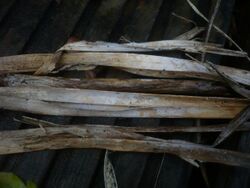Biology:Epithele
| Epithele | |
|---|---|

| |
| Epithele typhae, Bonnefont, France | |
| Scientific classification | |
| Kingdom: | |
| Division: | |
| Class: | |
| Order: | |
| Family: | |
| Genus: | Epithele (Pat.) Pat. (1900)
|
| Type species | |
| Epithele typhae (Pat.) Pat. (1900)
| |
| Synonyms | |
| |
Epithele is a genus of crust fungi in the family Polyporaceae.
Taxonomy
Epithele was first proposed in 1899 by French mycologist Narcisse Théophile Patouillard as a section of the genus Hypochnus. He included Hypochnus dussii and the type species, H. typhae, based on their similar appearance, habitat, and organization. Patouillard emphasized the presence of hyphal pegs as a major distinguishing characteristic of the genus.[1] Hyphal pegs are bundles of hyphae that originate in the trama and project into the hymenium. A year later, he raised Epithele to generic status, maintaining the same two species.[2] Hypochnus dussii later became the type of the genus Tubulicium.[3] Daisy Boquiren revised the genus in 1971, accepting 13 species.[4] Later contributions to the systematics of Epithele were made by Jülich (1976),[5] Boidin and Lanquetin (1983),[6] Boidin and Gilles (2000),[6] and Hjortstam and Ryvarden (2005).[7] In 2013, Karen Nakasone emended the generic concept to include Epithele bambusae (a species without hyphal pegs), and accepted 17 species.[8]
Species
(As of June 2017), Index Fungorum accepts 24 species of Epithele:[9]
- Epithele bambusae (Burt) K.K.Nakasone (2013)[8]
- Epithele bambusina Rick (1959)[10] – Brazil
- Epithele belizensis K.K.Nakasone (2013)[8]
- Epithele bisterigmata Boidin, Gilles & Duhem (2000)[6] – Réunion
- Epithele ceracea K.K.Nakasone (2013)[8]
- Epithele citrispora Boidin, Lanq. & Gilles (1983)[11]
- Epithele cylindricosterigmata Han C.Wang & Sheng H.Wu (2010)[12]
- Epithele efibulata Boidin, Lanq. & Gilles (1983)[11]
- Epithele fasciculata (G.Cunn.) Boidin & Gilles (1986)
- Epithele horridula Rick (1940)
- Epithele hydnoides Burt (1923)[13] – Hawaii
- Epithele interrupta Bres. (1914)[14] – Congo
- Epithele lutea Han C.Wang & Sheng H.Wu (2010)[12]
- Epithele macarangae Boidin & Lanq. (1983)[11]
- Epithele malaiensis Boidin & Lanq. (1983)[11]
- Epithele nikau G.Cunn. (1956)[15] – New Zealand
- Epithele nivea Rick (1959)[10] – Brazil
- Epithele ovalispora Boidin & Lanq. (1983)[11]
- Epithele reunionis Nakasone (2013)[8]
- Epithele ryvardenii Nakasone (2013)[8]
- Epithele straminea Rick (1959)[10] – Brazil
- Epithele subfusispora (Burds. & Nakasone) Hjortstam & Ryvarden (2005)[16] – South America
- Epithele sulphurea Burt (1920)[17] – North America
- Epithele typhae (Pers.) Pat. (1900)
References
- ↑ Patouillard, M. (1899). "Champignons de la Guadeloupe" (in fr). Bulletin Trimestriel de la Société Mycologique de France 15: 191–210. https://www.biodiversitylibrary.org/page/34205323.
- ↑ Patouillard, M. (1900) (in fr). Essai taxonomique sur les families et les genres des Hyménomycètes. Lons-le-Saunier: Lucien Declume. p. 59.
- ↑ Oberwinkler, F. (1965). "Primitive Basidiomyceten. Revision einiger Formenkreise von Basidienpilzen mit plastischer Basidie" (in de). Sydowia 19 (1–6): 1–72 (see p. 53).
- ↑ Boquiren, Daisy T. (1971). "The genus Epithele". Mycologia 63 (5): 937–957. doi:10.2307/3757896. http://www.cybertruffle.org.uk/cyberliber/59350/0063/005/0937.htm.
- ↑ Jülich, W. (1976). "Studies in hydnoid fungi – I. On some genera with hyphal pegs". Persoonia 8 (4): 447–458. http://www.cybertruffle.org.uk/cyberliber/61056/0008/004/0447.htm.
- ↑ 6.0 6.1 6.2 Boidin, J.; Gilles, G. (2000). "Basidiomycètes Aphyllophorales de l'île de La Réunion. XIX: Le genre Epithele (Pat.) Pat. 1900" (in fr). Bulletin Mensuel de la Société Linnéenne de Lyon 69 (9): 193–198. doi:10.3406/linly.2000.11346.
- ↑ Hjortstam, K.; Ryvarden, L. (2005). "Notes on the genus Epithele (Basidiomycotina, Aphyllophorales) from South America". Synopsis Fungorum 20: 23–32.
- ↑ 8.0 8.1 8.2 8.3 8.4 8.5 Nakasone, Karen K. (2013). "Taxonomy of Epithele (Polyporales, Basidiomycota)". Sydowia 65: 59–112. https://www.ncrs.fs.fed.us/pubs/jrnl/2013/nrs_2013_nakasone_001.pdf.
- ↑ Kirk, P.M.. "Species Fungorum (version 29th May 2017). In: Species 2000 & ITIS Catalogue of Life". http://www.catalogueoflife.org/col/browse/tree/id/e87bc717bdb343ead5bba5019b23cab8.
- ↑ 10.0 10.1 10.2 Rick, J.E. (1959). "Eubasidii in Rio Grande do Sul - Brasilia. 2. Thelephoraceae" (in es). Iheringia 4: 61–124 (see p. 87).
- ↑ 11.0 11.1 11.2 11.3 11.4 Boidin, J.; Lanquetin, P. (1983). "Basidiomycètes Aphyllophorales epitheloides étalés" (in fr). Mycotaxon 16 (2): 461–499.
- ↑ 12.0 12.1 Wang, H.C.; Wu, S.H.; Dai, Y.C. (2010). "Three new species of corticioid fungi with hyphal pegs". Mycologia 102 (5): 1153–1157. doi:10.3852/09-205. PMID 20943514.
- ↑ Burt, E.A. (1923). "Higher fungi of the Hawaiian Islands". Annals of the Missouri Botanical Garden 10 (2): 179–189. doi:10.2307/2394036. https://www.biodiversitylibrary.org/part/15936.
- ↑ De Wildeman, É. (1914). "Additions à la Flore du Congo" (in fr). Bulletin du Jardin Botanique de l'État à Bruxelles 4 (1): 1-241 (see p. 25). doi:10.2307/3666479.
- ↑ Cunningham, G.H. (1956). "Thelephoraceae of New Zealand. Part VII. The genus Lopharia. Part VIII. The genera Epithele and Mycobonia". Transactions and Proceedings of the Royal Society of New Zealand 83 (4): 621–636.
- ↑ Ryvarden, L.; Hjortstam, K. (2005). "Notes on Epithele from South America (Basidiomycotina, Aphyllophorales)". Synopsis Fungorum 20: 23–32.
- ↑ Burt, E.A. (1919). "The Thelephoraceae of North America. XI. Tulasnella, Veluticeps, Mycobonia, Epithele, and Lachnocladium". Annals of the Missouri Botanical Garden 6 (4): 253–280 (see p. 265). doi:10.2307/2990131. https://www.biodiversitylibrary.org/part/10909.
Wikidata ☰ Q5383689 entry
 |

